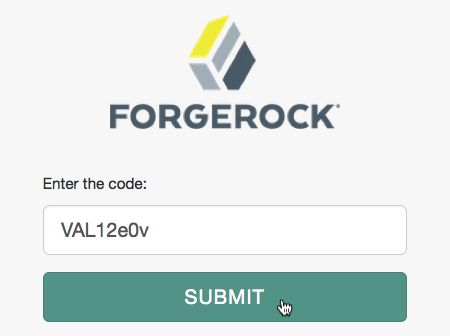Device Flow
The Device Flow is designed for client devices that have limited user interfaces, such as a set-top box, streaming radio, or a server process running on a headless operating system.
Rather than logging in by using the client device itself, you can authorize the client to access protected resources on your behalf by logging in with a different user agent, such as an Internet browser or smartphone, and entering a code displayed on the client device.
The steps in the diagram are described below:
The client device requests a device code from AM.
AM returns a device code, a user code, a URL for entering the user code, and an interval, in seconds.
The client device provides instructions to the user to enter the user code. The client may choose an appropriate method to convey the instructions, for example, text instructions on screen, or a QR code.
The client device begins to continuously poll AM to see if authorization has been completed.
If the user has not yet completed the authorization, AM returns an HTTP 403 status code, with an
authorization_pendingmessage.The user follows the instructions from the client device to enter the user code by using a separate device.
If the user code is valid, AM redirects the resource owner for authentication.
Upon authentication, the user is prompted to confirm the user code. The page is pre-populated with the one entered before.
The user can authorize the client device. The AM consent page also displays the requested scopes, and their values.
Note
AM does not display the confirmation nor the consent pages if the user has a valid session when they entered the code, and the client is allowed to skip consent.
This is also true if you perform the call using REST and pass the
decision=allowparameter.Upon authorization, AM responds to the client device's polling with an HTTP 200 status, and an access token, giving the client device access to the requested resources.
The following procedures show how to use the OAuth 2.0 device flow endpoints:
Devices can display a user code and instructions for a user, which can be used on a separate client to provide consent, allowing the device to access resources.
As user codes may be displayed on lower resolution devices, the list of possible characters used has been optimized to reduce ambiguity. User codes consist of a random selection of eight of the following characters:
234567ABCDEFGHIJKLMNOPQRSTVWXYZabcdefghijkmnopqrstvwxyz
This procedure assumes the following configuration:
AM is configured as an OAuth 2.0 authorization server. Ensure that:
The
tokenand thedevice_codeplugins are configured in the Response Type Plugins field.The
Device Codegrant type is configured in the Grant Types field.
For more information, see Authorization Server Configuration.
A public client called
myClientis registered in AM with the following configuration:Scopes:
writeResponse Types:
device_code tokenGrant Types:
Device Code
For more information, see Client Registration.
Perform the following steps to request a user code in the OAuth 2.0 device flow:
The client creates a POST request to the
/oauth2/device/codeendpoint specifying, at least, the following parameters:response_type=
device_codeclient_id=your_client_ID
For information about the parameters supported by the
/oauth2/device/codeendpoint, see "/oauth2/device/code". For information about private client authentication methods, see OAuth 2.0 Client Authentication.For example:
$
curl \ --request POST \ --data "response_type=device_code" \ --data "client_id=myClient" \ --data "scope=write" \ "https://openam.example.com:8443/openam/oauth2/realms/root/device/code"{ "interval": 5, "device_code": "7a95a0a4-6f13-42e3-ac3e-d3d159c94c55...", "verification_uri": "https://openam.example.com:8443/openam/oauth2/device/user", "verification_url": "https://openam.example.com:8443/openam/oauth2/device/user", "user_code": "VAL12e0v", "expires_in": 300 }On success, AM returns a verification URI (the
verification_urloutput is included to support earlier versions of the draft), and a user code to enter at that URL. AM also returns an interval, in seconds, that the client device must wait for in between requests for an access token.Tip
You can configure the returned values by navigating to Realms > Realm Name > Services > OAuth2 Provider > Device Flow.
The client device should now provide instructions to the user to enter the user code and grant access to the OAuth 2.0 device. The client may choose an appropriate method to convey the instructions, for example, text instructions on screen, or a QR code. Perform the steps in one of the following procedures:
To grant access to the client using a browser, see "To Grant Consent with a User Code Using a Browser in the Device Flow".
To grant access to the client without using a browser, see "To Grant Consent with a User Code Without Using a Browser in the Device Flow".
The client device should also begin polling the authorization server for the access token using the interval and device code information obtained in the previous step. For more information, see "To Poll for Authorization in the OAuth 2.0 Device Flow".
OAuth 2.0 Device Flow requires that the user grants consent to allow the client device to access the resources. The authorization server would then provide the client with an access token.
To grant consent with a user code without using a browser, perform the following steps:
The resource owner logs in to the authorization server, for example, using the credentials of the
demouser. For example:$
curl \ --request POST \ --header "Content-Type: application/json" \ --header "X-OpenAM-Username: demo" \ --header "X-OpenAM-Password: Ch4ng31t" \ --header "Accept-API-Version: resource=2.0, protocol=1.0" \ 'https://openam.example.com:8443/openam/json/realms/root/authenticate'{ "tokenId":"AQIC5wM...TU3OQ*", "successUrl":"/openam/console", "realm":"/" }The client makes a POST call to the authorization server's authorization device user endpoint specifying in a cookie SSO token of the
demoand, at least, the following parameters:user_code=resource_owner_user_code
decision=
allowcsrf=demo_user_SSO_token
For information about the parameters supported by the
/oauth2/device/userendpoint, see "/oauth2/device/user".The
iPlanetDirectoryProcookie is required and should contain the SSO token of the user granting access to the client. For example:$
curl \ --request POST \ --header "Cookie: iPlanetDirectoryPro=AQIC5wM...TU3OQ*" \ --data "user_code=VAL12e0v" \ --data "decision=allow" \ --data "csrf=AQIC5wM...TU3OQ*" \ "https://openam.example.com:8443/openam/oauth2/realms/root/device/user"The
scopeand theclient_idparameters have not been included because the user code already contains that information.AM returns HTML containing a JavaScript fragment named
pageData, with details of the result.Successfully allowing or denying access returns:
pageData = { locale: "en_US", baseUrl : "https://openam.example.com:8443/openam/XUI/", realm : "/\", done: true }done: truemeans that the flow can now continue.If the supplied user code has already been used, or is incorrect, AM returns the following:
pageData = { locale: "en_US", errorCode: "not_found", realm : "/\", baseUrl : "https://openam.example.com:8443/openam/XUI/" oauth2Data: { csrf: "ErFIk8pMraJ1rvKbloTgpp6b7GZ57kyk9HaIiKMVK3g=", userCode: "VAL12e0v", } }Important
As per Section 4.1.1 of the OAuth 2.0 authorization framework, it is required that the authorization server legitimately obtains an authorization decision from the resource owner.
Any client using the endpoints to register consent is responsible for ensuring this requirement, AM cannot assert that consent was given in these cases.
OAuth 2.0 Device Flow requires that the user grants consent to allow the client device to access the resources. The authorization server would then provide the client with an access token.
To grant consent with a user code using a browser, perform the following steps:
The resource owner navigates to the verification URL acquired with the user code, for example,
https://openam.example.com:8443/openam/oauth2/device/user.The resource owner logs in to the authorization server using, for example, the
demouser credentials.The resource owner enters their user code:
Note
If the user is not logged in to AM when they provide the code, AM redirects them to the login page.
After authenticating successfully, the user is prompted to enter the code again. The user code is pre-populated with the code they entered before.
The resource owner authorizes the device flow client by allowing the requested scopes:
Note
If the client is allowed to skip consent, the user will not see this screen.
AM adds the OAuth 2.0 client to the user's profile page in the Authorized Apps section and displays that the user is done with the flow:
The device now can request an access token from AM.
The client device must poll the authorization server for an access token, since it cannot know whether the resource owner has already given consent or not.
Perform the following steps to poll for an access token:
On the client device, create a POST request to poll the
/oauth2/access_tokenendpoint to request an access token specifying, at least, the following parameters:client_id=your_client_id
grant_type=
urn:ietf:params:oauth:grant-type:device_codedevice_code=your_device_code
For information about the parameters supported by the
/oauth2/access_tokenendpoint, see "/oauth2/access_token".The client device must wait for the number of seconds previously provided as the value of
intervalbetween polling AM for an access token. For example:$
curl \ --request POST \ --data "client_id=myClient" \ --data "grant_type=urn:ietf:params:oauth:grant-type:device_code" \ --data "device_code=7a95a0a4-6f13-42e3-ac3e-d3d159c94c55..." \ "https://openam.example.com:8443/openam/oauth2/realms/root/access_token"If the user has authorized the client device, an HTTP 200 status code is returned, with an access token that can be used to request resources:
{ "expires_in": 3599, "token_type": "Bearer", "access_token": "c1e9c8a4-6a6c-45b2-919c-335f2cec5a40" }If the user has not yet authorized the client device, an HTTP 403 status code is returned, with the following error message:
{ "error": "authorization_pending", "error_description": "The user has not yet completed authorization" }If the client device is polling faster than the specified interval, an HTTP 400 status code is returned, with the following error message:
{ "error": "slow_down", "error_description": "The polling interval has not elapsed since the last request" }Tip
The authorization server can also issue refresh tokens at the same time the access tokens are issued. For more information, see Refresh Tokens.


